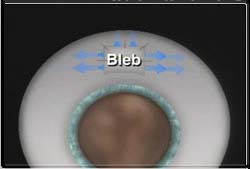Glaucoma Trabeculectomy Surgery in India

Abstract
BACKGROUND - Inflammatory glaucoma is still a diagnostic and therapeutic dilemma and surgical intervention is always associated with a high risk of failure or reactivation of the inflammatory disease. In this study we prospectively examined the value of transscleral diode laser cyclophotocoagulation (TDLC) for the treatment of refractory inflammatory glaucoma.
METHODS - 22 eyes of 20 consecutive patients with inflammatory, medically uncontrollable, glaucoma secondary to chronic uveitis/trabeculitis (n = 18), chemical injury (n = 2), episcleritis (n = 1), and necrotising scleritis with inflammation (n = 1) were treated by TDLC. Nine eyes (41%) had had previous failed glaucoma surgery (trabeculectomy, cyclocryocoagulation) and 15 eyes (68.2%) had had previous anterior segment surgery. All patients were followed for 1 year after the initial treatment.
RESULTS - Within 12 months of the first treatment the intraocular pressure was controlled in 77.3% of all eyes (72.2% of those with uveitic glaucoma). No serious side effects such as activation of the inflammatory process, phthisis bulbi or persistent hypotonia were observed, except one patient with a temporary fibrin reaction. More than one treatment was necessary in 63.6% of the patients. The use of systemic carbonic anhydrase inhibitors was reduced from 68.2% before treatment to 27.3% after 1 year.
CONCLUSION - TDLC seems to be a safe and effective procedure for the treatment of inflammatory glaucoma and may become an alternative to trabeculectomy with antimetabolites in uveitic glaucoma. TDLC may become the surgical procedure of choice in treating secondary glaucoma caused by chemical injury and also in scleritis associated glaucoma, using reduced parameters for application.
Introduction
Inflammatory glaucoma is still a diagnostic and therapeutic dilemma. The reliability of diagnostic procedures is often limited and new therapeutic procedures require a relatively long time to be evaluated because inflammatory glaucoma occurs in only a small number of eyes.1 Furthermore, some antiglaucomatous drugs such as miotics, metipranolol, and latanoprost seem to be contraindicated, not effective, or have not yet been investigated.2 3 Surgical intervention such as trabeculectomy or cyclocryotherapy is always associated with a high risk of failure or activation of the inflammatory disease. Further research is therefore needed on the therapeutic possibilities for inflammatory glaucoma.
Transscleral diode laser cyclophotocoagulation (TDLC) is a relatively new cyclodestructive procedure in the treatment of advanced refractory glaucoma. Although clinical experience is still limited, less severe side effects occur with this method than with cyclocryocoagulation or neodymium:YAG cyclophotocoagulation.4-6 Our own observations, as well as those reported in the literature, show that less inflammatory response is induced with cyclophotocoagulation than with cyclocryotherapy. Success rates of 38-85% have been reported with TDLC, regardless of the various differences between these studies.4-15 No large or prospective study has investigated the effectiveness and safety of TDLC in inflammatory glaucoma.
The purpose of this prospective study was to determine whether TDLC may be an effective, as well as safe, procedure for lowering intraocular pressure (IOP) in glaucoma caused by inflammatory ocular diseases.
Patients and methods
In January 1997 we initiated a prospective study to evaluate the effectiveness and safety of contact TDLC in cases of advanced glaucoma refractory to medical, surgical, or alternative treatments. Out of 100 consecutive patients, 20 patients (22 eyes) had inflammatory glaucoma without pupillary block and were mostly recruited from the outpatient service for inflammatory eye diseases at the University Eye Hospital, Tuebingen. Because information on the effectiveness of surgical procedures in inflammatory glaucoma is generally limited, we describe and discuss these patients separately.
All patients had inflammatory glaucoma which was uncontrolled despite maximum medical treatment. TDLC was performed if previous glaucoma surgery (trabeculectomy, cyclocryocoagulation) had failed, if there were additional risk factors for trabeculectomy (aphakia, pseudophakia), or if trabeculectomy and cyclocryocoagulation were associated with a very high risk of severe side effects (necrotising scleritis). All patients gave informed consent for cyclodiode treatment.
At our hospital subconjunctival anaesthesia was introduced as the standard procedure for TDLC in 1997.5 Oxybuprocaine, approximately 4-6 drops, was instilled in the eye and 2.5 ml 2% mepivacaine was then placed beneath the conjunctiva. The needle was carefully placed 6-8 mm from the limbus to avoid bleeding at the injection site near the limbus. The eye was patched for 15 minutes with low pressure. No sedation by oral or intravenous medication was given. Only a 9 year old child and a woman with anterior necrotising scleritis with staphyloma formation were treated under general anaesthesia. The laser energy was delivered through a contact fibreoptic G probe (IRIS Endoprobe) attached to the Oculight SLx semiconductor diode laser (Iris Medical Instruments Inc, CA, USA).
Treatment was defined as successful if the IOP could be reduced to 5-21 mm Hg with or without medication in all eyes with a visual acuity of at least 0.02 or more and in monocular patients. In eyes with a visual acuity of hand movements or less (including blind eyes) TDLC was performed to reduce a very high IOP to less than 30 mm Hg and, additionally, to reduce pain and avoid further complications and enucleation. A further aim of the treatment was reduction of the use of systemic carbonic anhydrase inhibitors in all patients. Normal treatment consisted of 10-15 applications of 2.0 W energy applied for 2 seconds to treat not more than 270° (not more than 180° in patients with glaucoma secondary to chemical injury). The energy level and length of treatment were reduced in cases of thinned sclera such as necrotising scleritis and after the occurrence of pop effects.
After surgery 0.5 ml dexamethasone was applied subconjunctivally. The patients received topical non-steroidal anti-inflammatory medication (diclofenac) five times a day (no cells or cells 1+ in the anterior chamber) or topical corticosteroids (prednisolone acetate 1%, cells >1+). Antiglaucomatous medication was continued and gradually withdrawn during the follow up period. At first, oral carbonic anhydrase inhibitors were withdrawn. If no adequate IOP response was obtained 6 weeks after the first treatment, patients underwent repeated TDLC for a maximum of four treatments.
Baseline information included age, race, sex, underlying inflammatory disease, visual acuity, IOP, medication, slit lamp biomicroscopic appearance, optic nerve head appearance, previous glaucoma, and other surgery. Follow up examinations were performed on the first day and after 6 weeks, 3 months, 6 months, 9 months, and 12 months. After every TDLC the effect of treatment was monitored after 6 weeks. At each follow up examination the visual acuity, IOP, medication, slit lamp biomicroscopic appearance, and complications were recorded.
Statistical analysis was performed using the paired t test to evaluate changes from baseline IOP and number of medications.
Results
Patient characteristics are shown in Table 1. Of the 22 eyes, nine (40.9%) had previous failed glaucoma surgery (trabeculectomy, laser trabeculoplasty, cyclocryocoagulation) and 15 (68.2%) had previous anterior segment surgery. In all patients the underlying inflammatory disease was controlled by anti-inflammatory medication before TDLC was performed and remained the same postoperatively.
Characteristics of patients and diagnosis
Only two patients were treated under general anaesthesia: a 60 year old woman with necrotising scleritis with inflammation and staphyloma formation (high risk of perforation) and a 9 year old girl with chronic anterior uveitis associated with juvenile chronic arthritis (JCA). In the remaining 18 patients sufficient anaesthesia was achieved by subconjunctival injection of mepivacaine 2%. During the follow up of 12 months, 44 TDLCs (mean of two treatments per eye) were performed. Eight eyes received a single treatment, seven eyes received two treatments, six eyes received three treatments, and one eye received four treatments. Because no response was seen in the child with JCA associated uveitis and glaucoma, a cyclocryocoagulation was performed 9 months after the initial TDLC. The symptoms in the patient with necrotising scleritis with inflammation were controlled with methotrexate. Because of the circular scleral thinning with staphyloma formation, the total energy for TDLC was reduced to nearly one quarter (12 laser spots, 1 second, 1.25 W). No activation of scleritis or uveitis was seen postoperatively and IOP was controlled.
The mean pretreatment IOP for all eyes (except the child with cyclocryocoagulation after 9 months) was 30.7 (SD7.3) mm Hg and significantly decreased to 21.5 (7.8) mm Hg after 6 weeks (p = 0.0002), 21.98 (7.6) mm Hg after 3 months (p = 0.0003), 18.7 (7.5) mm Hg after 6 months (p<0.0001), 17.8 (7.6) mm Hg after 9 months (p<0.0001), and to 19.4 (8.9) mm Hg at 12 months (p<0.0001). Successful lowering of IOP as defined above was achieved in 17 eyes (77.3%). The use of systemic carbonic anhydrase inhibitors was reduced from 68.2% before treatment to 27.3% after 1 year. The average number of topical antiglaucomatous drugs used was 2.55 (1.5) before surgery and 2.0 (1.2) after 12 months follow up ( p = 0.08).
The procedure failed in five eyes with uveitic glaucoma so the success rate in 18 eyes with uveitic glaucoma was 72.2%. Fifteen cyclophotocoagulations were performed in these five eyes. Two of the five eyes were aphakic; three had previous failed cyclocryocoagulation (including the child with JCA associated uveitis) and two a previous failed trabeculectomy.
In all 22 eyes no serious complications occurred during the 12 months following the initial treatment (Table 2). Nearly half of the patients had mild anterior uveitis on the first postoperative day. Only one female patient with secondary glaucoma after herpes keratouveitis and perforating keratoplasty had a fibrin reaction in the anterior chamber. Using subconjunctival dexamethasone and topical prednisolone acetate, the fibrin reaction disappeared after three days. No reactivation of the underlying inflammatory disease was seen.
Glaucoma Trabeculectomy Surgery in India is available in following cities
| Mumbai | Hyderabad | Kerala |
| Delhi | Pune | Goa |
| Bangalore | Nagpur | Jaipur |
| Chennai | Gurgaon | Chandigarh |
Go to the Enquiry Form
Phone Numbers Reach Us
India & International : +91-9860755000 / +91-9371136499
UK : +44-2081332571
Canada & USA : +1-4155992537
Below are the downloadable links that will help you to plan your medical trip to India in a more organized and better way. Attached word and pdf files gives information that will help you to know India more and make your trip to India easy and memorable one.
 Apollo Hospital
Apollo Hospital Fortis Hospital
Fortis Hospital Artemis Hospital
Artemis Hospital
 Medanta Hospital
Medanta Hospital



 Jaslok Hospital
Jaslok Hospital Lilavati Hospital
Lilavati Hospital

 Global Hospitals
Global Hospitals Jupiter Hospital
Jupiter Hospital













